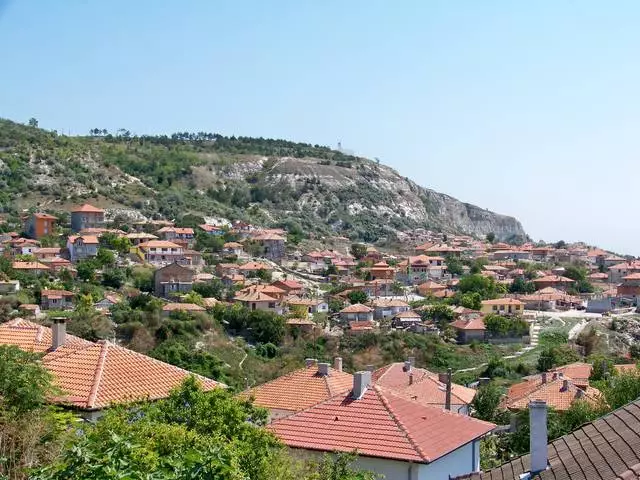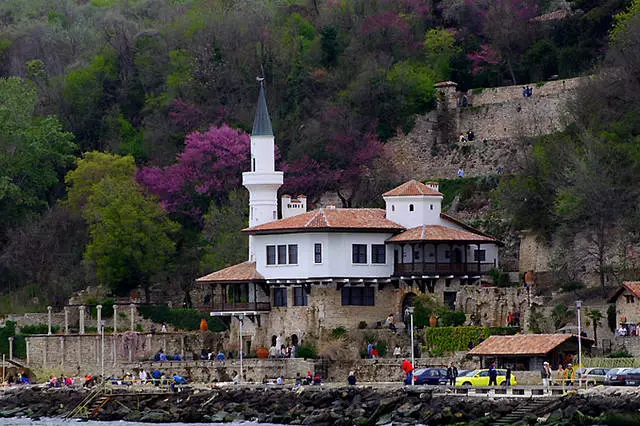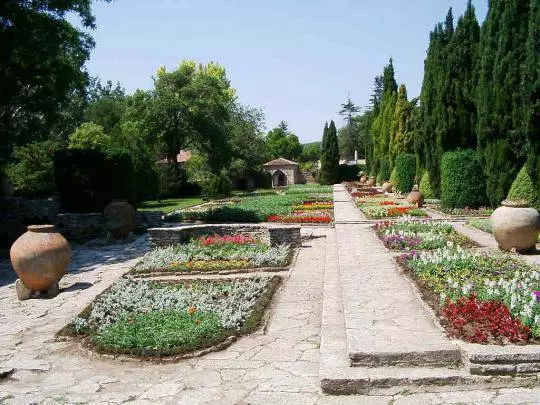This little city allows you to come to forget about all anxieties and reset the entire negative and bustle of everyday life, this place is intended only for enjoying pleasure from life, which is largely provided with local beauties. Ancient Balchik is a very peculiar place surrounded by white cliffs and endless sea. The local small houses having red roofs seem to many excellent inhabitants.

The characteristic architectural feature of this city is the location of all buildings in the form of amphitheater. It is possible that this fact is coupled with the unique decele of the environment and caused Mary's Romanian queen once the desire to build his summer residence here.
However, this city attracts a large number of visitors also thanks to another miracle - Pink Alley which is deservedly recognized as masterpiece of park creativity and in which approximately fifty species of these wonderful colors.
In addition, the city's fame brought Large collection of cacti She is considered the second largest in the Balkan Peninsula. The collection has more than two and a half hundred species of these exotic plants.
As for the history of the resort city ... Greeks founded the colony in these places in the sixth century - it was called, she was keen, and in the seventh century this city was included in the first Bulgarian kingdom, under the name of Karutun. It turned into a strategically important administrative center of the Car'un land.
In the fourteenth century, the settlement was part of the Dobrudazhan Principality. After that, the Ottoman Empire began to edit here, in this period the city and called it as we know it today - Balchik.
It is believed that this name occurred from the Gagauz word, which means a "small city". And in 1878, Bulgaria became an independent state.
In 1912, when the second Balkan War ended, South Dobrudzha was annexed Romania - including Balchik. During World War I, the city was returned to Bulgaria again, but with the termination of hostilities on this territory Romania again selected it.
In 1940, before the start of the Second World War, according to the provisions of the Kraiov peace treaty Romania returned to South Dobrudju (including Balchik) of Bulgaria.
Entertainment in Balchik such: there is a sandy beach equipped with sun loungers; Night discos, large water hill, pool complexes, banana walks, water skiing and surfing have great popularity among tourists.
Next to the most famous among visitors is the Palace of the Romanian Queen Mary. And the city of Balchik, in turn, is located at a distance of thirty-nine kilometers from Varna, in ten - from Albena and twenty-six - from golden sands. This location of the resort has a positive effect on ensuring the constancy of tourist excursions.
Palace of Queen Mary.
The main dick of the resort Balchik - the summer residence of the Romanian Queen Mary - is located on the sea coast, next to the central part of the city. This building does not differ in large size, however, a special charm gives it the originality of the inner decoration, interiors and furniture, as well as a beautiful park and a botanical garden around the palace.

At a very legitarious question about why the Palace of the Romanian Queen is located in Bulgarian territory, there is a reasonable answer - because this area at different times was under the control of various states - Bulgaria and Romania. The government came here in 1921. She was impressed by local natural beauty and maritime climate, so she wanted to arrange a palace here - a summer residence, calling him "Thach of Juve", which means "quiet nest". In his construction, architects from Italy took part, and the Master Florist from Switzerland built a park.
Queen Mary (Maria Alexandrina Victoria de Edinburgh) had a good education and elegant taste. Her young years have passed in Egypt, Maria had a passion for the religion of Bahai. Today, in the architectural features of the buildings included in the palace ensemble, traditional motives of the Romanian, Balkan, Byzantine, antique and Turkish art can be found. From above over the palace minaret.
Longitudinal stone terraces and cascade waterfalls are lowered down the slopes. Surrounded by roses, comfortable arbors are located. Among other things, guest villas are built in the park, Roman terms, where he loved to be the government, as well as the chapel and a small power plant.
Palace building, which has three levels, is a Bulgarian white house, which is decorated with Arab ornaments and mounted wooden terraces overlooking the sea. A large room is located in the building, in which the government had the opportunity to simultaneously collect the entire servant. Acoustics here is excellent. Nowadays, you can see unique icons here, who gave the Queen of Maria Cypriot monks - for the Palace Chapel.
Near the Big Hall is a breakpoint of a government and a bathroom that has a very large similarity with a Turkish bath. In the building of the palace there are original doors made of wood and iron, stoves, mirrors, a wardrobe, Constantinople and a lot more.
The government of Maria had a fun temper and creative abilities. People of art came to the palace from around the world - musicians, painters, poets, as well as "cream" of the then society. The queen also was engaged in drawing and writing - she wrote, using the pseudonym Carmen Silva. Today, her summer residence is also a cultural center of the state. With regular times in two weeks, various exhibitions, festivals and meetings of creative figures are organized here.

The Palace of the Romanian government of Mary is a combination of magic beauties, ancient soul and atmosphere of creativity. The construction fits into the surrounding natural environment without significant harm for it, and natural differences have creative design. Any of the garden elements is a plant or the architecture masterpiece - narrates to visitors that the whole situation was created by people creatively gifted, which are committed to art.
